Arsenic trioxide
Arsenic trioxide, sold under the brand name Trisenox among others, is an inorganic compound and medication.[2] As an industrial chemical, major uses include in the manufacture of wood preservatives, pesticides, and glass.[3] As a medication it is used to treat a type of cancer known as acute promyelocytic leukemia.[2] For this use it is given by injection into a vein.[2]
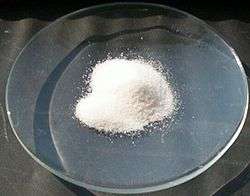 | |
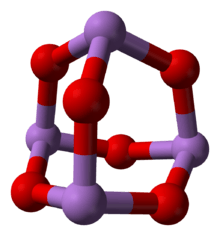 | |
| Clinical data | |
|---|---|
| Trade names | Trisenox, others |
| Other names | Arsenic(III) oxide, Arsenic sesquioxide, Arseneous oxide, Ratsbane, Arseneous anhydride, White arsenic, Aqua Tofani[1] |
| AHFS/Drugs.com | Monograph |
| MedlinePlus | a608017 |
| License data | |
| Pregnancy category |
|
| Routes of administration | Intravenous |
| Drug class | Antineoplastic agent |
| ATC code | |
| Legal status | |
| Legal status | |
| Pharmacokinetic data | |
| Protein binding | 75% |
| Excretion | Urine |
| Identifiers | |
| |
| CAS Number | |
| PubChem CID | |
| DrugBank | |
| ChemSpider | |
| UNII | |
| KEGG | |
| ChEMBL | |
| CompTox Dashboard (EPA) | |
| ECHA InfoCard | 100.014.075 |
| Chemical and physical data | |
| Formula | As2O3 |
| Molar mass | 197.840 g·mol−1 |
| 3D model (JSmol) | |
| Density | 3.74 g/cm3 |
| Melting point | 312.2 °C (594.0 °F) |
| Boiling point | 465 °C (869 °F) |
| Solubility in water | 20 g/L (25 °C) see text |
| |
| |
| Data page | |
| Arsenic trioxide (data page) | |
Common side effects include vomiting, diarrhea, swelling, shortness of breath, and headaches.[2] Severe side effects may include APL differentiation syndrome and heart problems.[2] Use during pregnancy or breastfeeding may harm the baby.[4][5] Arsenic trioxide has the formula As
2O
3.[6] How it works in cancer is not entirely clear.[2]
Arsenic trioxide was approved for medical use in the United States in 2000.[2] It is on the World Health Organization's List of Essential Medicines.[7] Approximately 50,000 tonnes are produced a year.[8] Due to its toxicity a number of countries have regulations around its manufacture and sale.[9]
Uses
Medical
Arsenic trioxide is used to treat a type of cancer known as acute promyelocytic leukemia (APL).[2] It may be used both in cases that are unresponsive other agents, such as all-trans retinoic acid (ATRA) or as part of the initial treatment of newly diagnosed cases.[2] This initial treatment may include combination therapy of arsenic trioxide with all-trans retinoic acid (ATRA).[10]
Effectiveness appears similar to Realgar/Indigo naturalis, which can be taken by mouth and is less expensive but is less available.[11]
In the 1970s, Chinese researcher Zhang Tingdong and colleagues discovered this use.[12] It was approved for leukemia treatment in the United States in 2000.[13] University of Hong Kong developed a liquid form of arsenic trioxide that can be given by mouth.[14] Organoarsenic compounds, such as feed additives (roxarsone) and medication (neosalvarsan), are derived from arsenic trioxide.
Manufacturing
Industrial uses include usage as a precursor to forestry products, in colorless glass production, and in electronics.[8] Being the main compound of arsenic, the trioxide is the precursor to elemental arsenic, arsenic alloys, and arsenide semiconductors. Bulk arsenic-based compounds sodium arsenite and sodium cacodylate are derived from the trioxide.
A variety of applications exploit arsenic's toxicity, including the use of the oxide as a wood preservative. Copper arsenates, which are derived from arsenic trioxide, are used on a large scale as a wood preservative in the U.S. and Malaysia, but such materials are banned in many parts of the world. This practice remains controversial.[8] In combination with copper(II) acetate, arsenic trioxide gives the vibrant pigment known as Paris green used in paints and as a rodenticide. This application has been discontinued.
Alternative medicine
Despite the well known toxicity of arsenic, arsenic trioxide was used in traditional Chinese medicine, where it is known as pi-shuang (Chinese: 砒霜; pinyin: pīshuāng; lit.: 'arsenic frost'. In homeopathy, it is called arsenicum album. Some discredited patent medicines, e.g., Fowler's solution, contained derivatives of arsenic oxide.[15]
Toxicology
Arsenic trioxide is readily absorbed by the digestive system: toxic effects are also well known upon inhalation or upon skin contact. Elimination is rapid at first (half-life of 1–2 days), by methylation to monomethylarsonic acid and dimethylarsonic acid, and excretion in the urine, but a certain amount (30–40% in the case of repeated exposure) is incorporated into the bones, muscles, skin, hair and nails (all tissues rich in keratin) and eliminated over a period of weeks or months.
The first symptoms of acute arsenic poisoning by ingestion are digestive problems: vomiting, abdominal pains, diarrhea often accompanied by bleeding. Sub-lethal doses can lead to convulsions, cardiovascular problems, inflammation of the liver and kidneys and abnormalities in the coagulation of the blood. These are followed by the appearance of characteristic white lines (Mees' lines) on the nails and by hair loss. Lower doses lead to liver and kidney problems and to changes in the pigmentation of the skin. Even dilute solutions of arsenic trioxide are dangerous on contact with the eyes.
The poisonous properties are well known and the subject of an extensive literature.[16][17][18]
Chronic arsenic poisoning is known as arsenicosis. This disorder affects workers in smelters, in populations whose drinking water contains high levels of arsenic (0.3–0.4 ppm), and in patients treated for long periods with arsenic-based pharmaceuticals. Similarly, studies on workers exposed in copper foundries in the U.S., Japan and Sweden indicate a risk of lung cancer 6–10 times higher for the most exposed workers compared with the general population. Long-term ingestion of arsenic trioxide either in drinking water or as a medical treatment can lead to skin cancer. Reproductive problems (high incidences of miscarriage, low birth weight, congenital deformations) have also been indicated in one study of women exposed to arsenic trioxide dust as employees or neighbours of a copper foundry.
In Austria, there lived the so-called "arsenic eaters of Styria", who ingested doses far beyond the lethal dose of arsenic trioxide without any apparent harm. Arsenic is thought to enable strenuous work at high altitudes, e.g. in the Alps.[19][20][21][22]
In the U.S., the OSHA 1910.1018 occupational permissible exposure limit for inorganic arsenic compounds in breathing zone air is 0.010 mg/m3.
Production and occurrence

Arsenic trioxide can be generated via routine processing of arsenic compounds including the oxidation (combustion) of arsenic and arsenic-containing minerals in air. Illustrative is the roasting of orpiment, a typical arsenic sulfide ore.
- 2 As
2S
3 + 9 O
2 → 2 As
2O
3 + 6 SO
2
Most arsenic oxide is, however, obtained as a volatile by-product of the processing of other ores. For example, arsenopyrite, a common impurity in gold- and copper-containing ores, liberates arsenic trioxide upon heating in air. The processing of such minerals has led to numerous cases of poisonings.[23] Only in China are arsenic ores intentionally mined.[8]
In the laboratory, it is prepared by hydrolysis of arsenic trichloride:[24]
- 2 AsCl3 + 3 H2O → As2O3 + 6 HCl
As
2O
3 occurs naturally as two minerals, arsenolite (cubic) and claudetite (monoclinic). Both are relatively rare secondary minerals found in oxidation zones of As-rich ore deposits. Sheets of As2O3 stand for part of structures of the recently discovered minerals lucabindiite, (K,NH4)As4O6(Cl,Br),[25] and its sodium-analogue torrecillasite.[26]
Properties and reactions
Arsenic trioxide is an amphoteric oxide, and its aqueous solutions are weakly acidic. Thus, it dissolves readily in alkaline solutions to give arsenites. It is less soluble in acids, although it will dissolve in hydrochloric acid.[27]
With anhydrous HF and HCl, it gives AsF3 and the trichloride:[24]
- As2O3 + 6 HX → 2 AsX3 + 3 H2O (X = F, Cl)
Only with strong oxidizing agents such as ozone, hydrogen peroxide, and nitric acid does it yield arsenic pentoxide, As
2O
5 or its corresponding acid:[24]
- 2 HNO3 + As2O3 + 2 H2O → 2 H3AsO4 + N2O3
In terms of its resistance to oxidation, arsenic trioxide differs from phosphorus trioxide, which readily combusts to phosphorus pentoxide.
Reduction gives elemental arsenic or arsine (AsH
3) depending on conditions:[24]
- As2O3 + 6 Zn + 12 HNO3 → 2 AsH3 + 6 Zn(NO3)2 + 3 H2O
This reaction is used in the Marsh test.
Structure
In the liquid and gas phase below 800 °C, arsenic trioxide has the formula As
4O
6 and is isostructural with P
4O
6. Above 800 °C As
4O
6 significantly dissociates into molecular As
2O
3, which adopts the same structure as N
2O
3. Three forms (polymorphs) are known in the solid state: a high temperature ( > 110 °C) cubic As
4O
6, containing molecular As
4O
6, and two related polymeric forms.[28] The polymers, which both crystallize as monoclinic crystals, feature sheets of pyramidal AsO
3 units that share O atoms.[29]
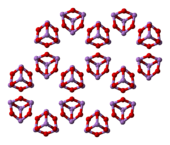 |
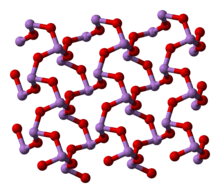 |
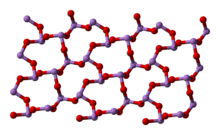 |
(cubic) | (monoclinic) | (monoclinic) |
Society and culture
Cost
In the United Kingdom it costs the NHS £292 a dose as of 2018.[4] In the United States this amount costs about US$508 as of 2019.[4] With initial treatment being 60 days the cost for a course of treatment is £17,520 and US$30,000 respectively.[4][4]
Environmental effects
Smelting and related ore processing often generate arsenic trioxide, which poses a risk to the environment. For example, the Giant Mine in Canada processed substantial amounts of arsenopyrite-contaminated gold ores.
References
- Shakhashiri, B. Z. "Chemical of the Week: Arsenic". University of Wisconsin-Madison Chemistry Dept. Archived from the original on 2008-08-02. Retrieved 2008-08-03.
- "Arsenic Trioxide Monograph for Professionals". Drugs.com. Retrieved 15 November 2019.
- Landner, Lars (2012). Chemicals in the Aquatic Environment: Advanced Hazard Assessment. Springer Science & Business Media. p. 259. ISBN 9783642613340.
- British national formulary : BNF 76 (76 ed.). Pharmaceutical Press. 2018. p. 907. ISBN 9780857113382.
- "Arsenic trioxide (Trisenox) Use During Pregnancy". Drugs.com. Retrieved 16 November 2019.
- Sun, Hongzhe (2010). Biological Chemistry of Arsenic, Antimony and Bismuth. John Wiley & Sons. p. 295. ISBN 9780470976227.
- World Health Organization (2019). World Health Organization model list of essential medicines: 21st list 2019. Geneva: World Health Organization. hdl:10665/325771. WHO/MVP/EMP/IAU/2019.06. License: CC BY-NC-SA 3.0 IGO.
- Grund, S. C.; Hanusch, K.; Wolf, H. U. "Arsenic and Arsenic Compounds". Ullmann's Encyclopedia of Industrial Chemistry. Weinheim: Wiley-VCH. doi:10.1002/14356007.a03_113.pub2.
- Consolidated List of Products Whose Consumption And/or Sale Have Been Banned, Withdrawn, Severely Restricted Or Not Approved by Governments: Chemicals. United Nations Publications. 2009. p. 24. ISBN 9789211302196.
- Zhu, J.; Chen, Z.; Lallemand-Breitenbach, V.; De Thé, H. (2002). "How acute promyelocytic leukaemia revived arsenic". Nature Reviews Cancer. 2 (9): 705–714. doi:10.1038/nrc887. PMID 12209159.
- "Proposal for the inclusion of arsenic therapies in the WHO Model list of ESSENTIAL MEDICINES for the treatment of acute promyelocytic leukemia" (PDF). WHO. Retrieved 15 November 2019.
- Rao Y, Li R, Zhang D (June 2013). "A drug from poison: how the therapeutic effect of arsenic trioxide on acute promyelocytic leukemia was discovered". Sci China Life Sci. 56 (6): 495–502. doi:10.1007/s11427-013-4487-z. PMID 23645104.
- Bian Z, Chen S, Cheng C, Wang J, Xiao H, Qin H (2012). "Developing new drugs from annals of Chinese medicine". Acta Pharmaceutica Sinica B. 2: 1–7. doi:10.1016/j.apsb.2011.12.007.
- Au, W.-Y.; Kumana, C. R.; Kou, M.; Mak, R.; Chan, G. C.; Lam, C.-W.; Kwong, Y.-L. (2003). "Oral arsenic trioxide in the treatment of relapsed acute promyelocytic leukemia". Blood. 102 (1): 407–408. doi:10.1182/blood-2003-01-0298. PMID 12814916.
- Gibaud, S.; Jaouen, G. (2010). "Arsenic-Based Drugs: From Fowler's Solution to Modern Anticancer Chemotherapy". Topics in Organometallic Chemistry. Topics in Organometallic Chemistry. 32: 1–20. doi:10.1007/978-3-642-13185-1_1. ISBN 978-3-642-13184-4.
- "Stanton v Benzler 9716830". U.S. 9th Circuit Court of Appeals. 1998-06-17. Retrieved 2008-06-09.
(...) convicted by a jury of first degree murder for poisoning her ex-husband. Her ex-husband's body was found with traces of arsenic trioxide in it.
- Emsley, J. (2006). "Arsenic". The Elements of Murder: A History of Poison. Oxford University Press. pp. 93–197. ISBN 978-0-19-280600-0.
- Flaubert, G. (1856). Madame Bovary.
- "Arsenic Eaters". New York Times. July 26, 1885.
- Allesch, R. M. (1959). Arsenik. Seine Geschichte in Österreich. Archiv für vaterländische Geschichte und Topographie. 54. Klagenfurt: Kleinmayr.
- Przygoda, G.; Feldmann, J.; Cullen, W. R. (2001). "The arsenic eaters of Styria: a different picture of people who were chronically exposed to arsenic". Applied Organometallic Chemistry. 15 (6): 457–462. doi:10.1002/aoc.126.
- Whorton, J. C. (2010). The Arsenic Century. Oxford University Press. pp. 270–273. ISBN 978-0-19-960599-6.
- "Giant Mine – Northwest Territories Region – Indian and Northern Affairs Canada". Archived from the original on 2004-08-12. Retrieved 2007-08-28.
- Handbook of Preparative Inorganic Chemistry, 2nd Ed. Edited by G. Brauer, Academic Press, 1963, NY.
- Garavelli et al. 2013, http://www.minsocam.org/msa/ammin/toc/Abstracts/2013_Abstracts/FM13_Abstracts/Garavelli_p470_13.pdf
- Kampf et al. 2013, http://minmag.geoscienceworld.org/content/78/3/747.abstract
- Greenwood, N. N.; & Earnshaw, A. (1997). Chemistry of the Elements (2nd Edn.), Oxford:Butterworth-Heinemann. ISBN 0-7506-3365-4.
- Wells A.F. Structural Inorganic Chemistry. 5th. London, England: Oxford University Press, 1984. Print. ISBN 0-19-855370-6
- Holleman, A. F.; Wiberg, E. (2001). Inorganic Chemistry. San Diego: Academic Press. ISBN 0-12-352651-5.
External links
- "Arsenic trioxide". Drug Information Portal. U.S. National Library of Medicine.
- Case Studies in Environmental Medicine: Arsenic Toxicity
- "Arsenic and Arsenic Compounds". Summaries & Evaluations. International Agency for Research on Cancer (IARC). February 1998.
- International Chemical Safety Card 0378
- NIOSH Pocket Guide to Chemical Hazards
- NTP Report on Carcinogens – Inorganic Arsenic Compounds
- Institut national de recherche et de sécurité (1989). "Trioxyde d'arsenic." Fiche toxicologique n° 89. Paris:INRS. (in French)
- Institute of Chemistry Austria, specialised on arsenic and various arsenic compounds